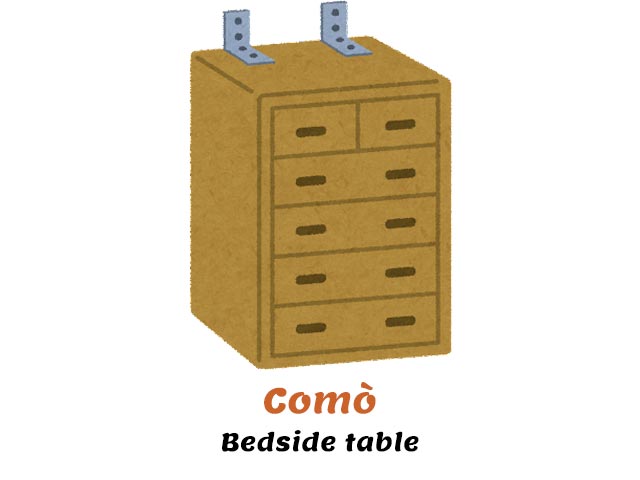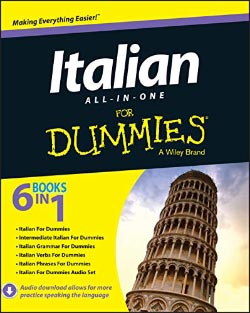Vowels are sounds that we make when the air from our lungs can flow freely out of our mouth.
A E I O U
(Vowel letters in Italian)

How do the Italian vowels work? How many are there? Read on to find the answer to these and other questions in this ultimate guide to the vowels in Italian!
Italian vowels
There are 5 vowel letters (graphemes) in Italian, and 7 vowel sounds (phonemes).
The letters are: A, E, I, O and U. Unlike English, they are pure sounds. They are not diphthongs.
A, E, I, O, U
A, E, I, O, U
The vowels E and O, however, can be either open or closed.
E, E
Vowel E open and closed
O, O
Vowel O open and closed
In the International Phonetic Alphabet, the Italian vowels are represented as follows.
| A | /a/ |
| E (open) | /ɛ/ |
| E (closed) | /e/ |
| I | /i/ |
| O (open) | /ɔ/ |
| O (closed) | /o/ |
| U | /u/ |
Title: Italian All-in-One For Dummies
Language: English / Italian
Publisher: For Dummies
Pages: 672
Learn to speak Italian like a native? Easy.
Italian All-in-One For Dummies appeals to those readers looking for a comprehensive, all-encompassing guide to mastering the Italian language. It contains content from all For Dummies Italian language instruction titles, including Italian For Dummies, Intermediate Italian For Dummies, Italian Verbs For Dummies, Italian Phrases For Dummies, Italian Grammar For Dummies, and Italian For Dummies Audio Set.
Although the quality of the vowels E and O in any given word is dictated by pronunciation rules, these rules are almost never followed by native speakers because pronunciation varies greatly from place to place in the country, so there’s really no “wrong” way to pronounce the vowels in Italian.
Only standard Italian, the accent that used on television, on the radio and in movie dubbing, actually follows the rules, but nobody speaks it in real life because the influence of regional accents is very strong.
Also, there’s no way people can misunderstand you if you pronounce an open E instead of a closed E. Homographs such as pésca (closed E) and pèsca (open E) are very rare.
Pesca
Fishing
Pesca
Peach

If you say pesca with an open E and mean “fishing” instead, which requires a closed E, people will have no problem understanding you given the context.
For example, in my regional accent, both “fishing” and “peach” are pronounced as pésca, with a closed E. I’ve never had any problems distinguishing between the two, provided some context is given.
How can you tell if a vowel is open or closed?
Open any Italian dictionary and look up any word. In dictionaries…
- open vowels are represented by a grave accent (`)
- closed vowels are represented by an acute accent, (´).
For example, you could read…
Lèggere
To read
Vénti
Twenty
Fòto
Photo
Córto
Short

Writing vowels in Italian
When writing, you don’t need to add any accent marks over vowels that are stressed in the middle of a word: you will write leggere, foto, corto.
However, you can add the accent mark when you want to distinguish between homographs that have no context, to avoid any misunderstandings, and you must add the accent mark to almost all words whose stress falls on the last syllable, such as perché or caffè.
Perché
Why, because
Caffè
Coffee
You’ll notice that the final -e in perché is closed (acute accent) and the -e in caffè is open (grave accent) because that is how the words should be pronounced in standard Italian.
There’s really no difference in the way you write accent marks when you write by hand, but when you type words on a computer, you have to use the correct mark. Pronouncing perché with an open E is not a mistake, but writing perchè is.
When in final position, the vowel O is always pronounced as an open sound, so it is always -ò.
Però
But
Comò
Bedside table

All other Italian words with stress on the last syllable are written with a grave accent, never with an acute accent.
Velocità
Speed
Colibrì
Hummingbird
Zulù
Zulu tribe
Any good text editor will underline spelling mistakes in Italian, but learn how to write these words by heart just to be sure.
And that’s it for the Italian vowels! If you still have any doubts, feel free to leave a comment.
Now what?
Now that you’ve seen how the Italian vowels work, you might want to keep learning Italian online with these free Italian resources:
- Useful Italian Words Series
- Common Italian Phrases Series
- Italian grammar lessons and tricks
- Italian idiomatic expressions
Or you might also want an excellent offline Italian grammar resource to take with you at all times (Amazon).
❤️ If you liked this guide on the vowels in Italian, consider sharing it with your social media friends who are also studying Italian.




